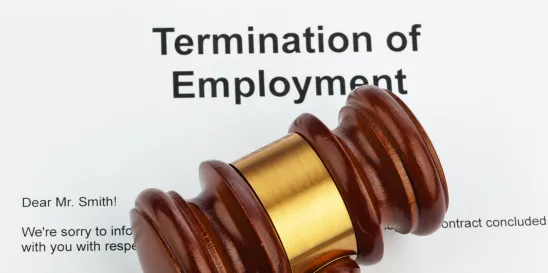No matter the size of your organization, at some point in time employees leave. As we noted previously, it behooves human resources and other departments to provide departing employees with an exit letter that includes important dates, deadlines, and reminders. In addition, watch out for the items below and consider including one or more of them as part of any exit letter or severance agreement (especially for departing officers and senior management).
401(k) Contributions: Severance Doesn’t Count, but Post-Termination Payments Could
No, that isn’t a typo, so what does it mean? In general, there are two kinds of post-employment pay given to former employees: (1) severance pay, which doesn’t relate to payment for services rendered and wouldn’t have been paid if employment had continued, and (2) post-termination pay, which is pay or benefits that would have been paid or received if employment had continued, such as a final paycheck or vacation cash out, in either case, paid after termination. Some advisors call severance “go-away pay,” and it never counts as compensation for 401(k) contributions. Post-termination pay, however, is fact dependent and you need to read the definitions and terms of your 401(k) plan to know whether it includes such pay (compensation); if it’s included, then a timing requirement will also apply, such as two and a half months after separation, so you will need to know or have a good idea of when the post-termination payments will occur.
Make Sure to Read, and Maybe Follow, any Employment or Other Contract
What’s Required, What’s Negotiable
When deciding what post-termination benefits to provide or ask for, we recommend first reviewing any existing employment agreement or other governing contract. (In addition to employment agreements, employees may have other contracts or plans that need reviewing, such as equity awards, supplemental executive retirement plans, and non-compete agreements, which are discussed below.) Whether recently enacted or several years old, governing contracts provide the starting point not only for what’s legally required but also for how negotiations may proceed. Something that was much sought after or bargained for in the past may no longer have such swaying power. The parties may negotiate to provide something different than what’s in the governing contract, but savvy employers will not only review all agreements first they will also carefully draft and include a merger clause in the severance agreement, basically providing that the severance agreement is the controlling document for severance benefits and that it specifically overrides any former agreements or contracts.
Watch Out for 409A
Notwithstanding the general rule about negotiation, everyone should pay extra attention to Internal Revenue Code Section 409A (409A) issues if the form or timing of payments changes between what was required under the original contract and what’s provided under the severance agreement. While heavily fact-specific, certain changes may result in immediate taxation and an additional 20% excise tax under 409A, a situation nobody wants. For example, an employment agreement may provide a cash severance payment equal to two years of base salary payable over twenty-four months beginning 60 days after termination. Whether those payments can be accelerated into a lump sum payment payable 60 days after termination depends on additional facts and more specifics of the original agreement. You want to seek someone with a solid understanding of 409A and its many intricacies before changing the time and form of any payments previously agreed to.
COBRA & Other Post-Termination Welfare: Be Careful with Your Promises
While welfare benefits can be many and varied, three post-termination benefits often asked about include subsidized COBRA benefits, group life insurance, and long-term disability. They’re nuanced and contain enough traps to warrant further discussion.
Subsidized COBRA Benefits
As we’ve talked about before, it’s typical for many employers to subsidize the cost of COBRA continuation for terminating employees, often providing that the person will be responsible only for paying active employee rates during all or some portion of the standard 18-month COBRA period. Those wishing to offer this benefit should remember the following:
- Self-Insured or Fully-Insured Health Coverage? If you have a self-insured plan and provide subsidized coverage to a “highly compensated individual,” then the value of the benefit (generally the value of the employer-paid portion of the COBRA premiums) is taxable to the person as W-2 income. If you have a fully insured plan, then there are no tax consequences now, but if and when regulations under the Affordable Care Act go into effect, a $100 per day excise tax on the employer will apply. Employers wishing to protect against that liability may add a savings clause to a separation agreement providing that if needed to avoid such penalties, the employer retains the right to provide a taxable cash payment or other benefit in lieu of such subsidized coverage.
- Who Pays for Coverage and How is it Done? If the employer pays the insurance company directly (or directly offsets the cost of self-insured COBRA), or if it requires the former employee to submit proof for reimbursement or payment of the benefit, then the value won’t be taxed (unless the highly compensated self-insured situation above exists). But, if the employer simply pays cash, even with an understanding (but no obligation) that it be used for COBRA, then the payment will be taxable as W-2 income.
- When Does Subsidized Coverage End? It may seem obvious, but any separation or similar agreement should specifically note how long subsidized coverage lasts, whether the standard 18-month COBRA period or something shorter, like 12 or 6 months. In addition, best practice dictates that the letter or agreement be clear that the subsidized period runs as part of the standard COBRA period, not in addition to it, assuming that’s the business arrangement.
Group Life Insurance
Employers wanting to avoid challenging situations may decide against promising any ongoing life insurance benefit post-termination. Instead, better practice calls for noting in the separation agreement or other writing to the employee about the right to convert the group life insurance coverage to an individual policy. Alternatives exist, such as obtaining a one-person policy through an insurance company, but those quickly become challenging situations because of the cost and administrative work involved. If the soon-to-be former employee pushes for the benefit, a compromise may be increased severance, which would be taxable to the individual but far easier for the employer to administer because it becomes the individual’s responsibility to find a replacement for that benefit.
Long-Term Disability
Generally, companies should avoid making any promises to provide long-term disability beyond termination (except as may otherwise be covered under the employer’s long-term disability policy), whether that’s done with explicit language or with global references to employer benefits. Promises or inferences otherwise may lead to the employer providing the benefit out of its own coffers, because insurance coverage will end for the departing employee, leaving the employer on the hook, and means the employer then administers a benefit that should generally only apply for actual employees, with unknown or very uncertain terms. Instead, employers would do well to specifically mention when such coverage will end, cross-referencing the applicable plans and policies.
Non-Competes: Are They Legally Effective & What’s the Harm if Not?
Sometimes employment contracts have non-competes built in, sometimes they are separate agreements, and sometimes they are included as part of the separation agreement or otherwise entered into at termination. Regardless of how they come about, they have been a hot topic of legislation and litigation for the past several years. If you want to rely on them for current or future use, we encourage you to work with trusted counsel and remember:
Beware of Restrictions or Outright Prohibitions
The number of states and other localities that prohibit or heavily regulate non-competes and similar restrictive covenants is significant and ever-changing, so a document or information you relied on even one year ago deserves review and possible revision. In addition, states that allow non-competes often do so with caveats and contingencies, such as imposing income thresholds prohibiting non-competes for low-earning employees, as our labor and employment colleagues have discussed, further proving that the world of non-competes remains fluid and open for discussion.
Beware of Deterrent Reliance
Sometimes employers will add or rely on non-competes they know or suspect are legally unenforceable or overbroad, with the idea being maybe its presence alone will deter someone from competing. As our colleagues have noted previously, this “what’s the harm in trying” approach can lead to civil (and sometimes criminal) penalties for improper enforcement of non-competes, with nine states as of July 2023 imposing such penalties. Unbounded use of non-competes could lead to unintended and very negative consequences, so it’s best to consult with someone very knowledgeable about non-competes before moving forward with them.





 />i
/>i
